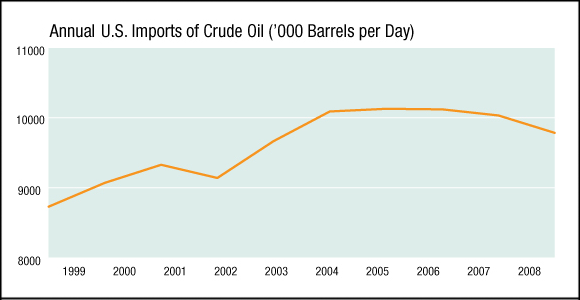By Margaret McQuaile
February 10 - Late 2009, Saudi Arabia gave up its oil storage lease at
the St Eustatius terminal in the Caribbean to Petrochina.
The transfer of a lease held by the Saudis since the mid-1990s looked
like the latest indication of a diminishing commitment to the US market.
Saudi Aramco's Caribbean storage has been an important background
feature of the Western Hemisphere oil market over the years, enabling
the Saudis to move barrels quickly into key areas when needed.
Now, the kingdom is seeking storage in Asia and has been talking for
some time to the Japanese, who are offering facilities on the island of
Okinawa and who have already signed a basic agreement on a joint
strategic stockpiling project with Abu Dhabi that would prioritize the
supply of crude to Japan in an emergency.
The Saudis have made no secret of their increasing focus on Asia, which
is expected to provide the bulk of future growth in oil demand and which
accounted for 52.7% of Saudi oil exports in 2008 -- up from 47.9% in
2005.
"We are the number one supplier of crude oil to major economies such as China, Japan, Korea and India, in addition to being a major supplier to the world's biggest crude oil consumer and its single largest economy, the United States," Aramco said last May as it released its 2008 Annual Review.

But while the kingdom remains a major supplier to the US, its volumes and share of total crude imports have fallen back sharply, particularly over the past year. (See related chart: Monthly U.S. Imports of Crude Oil ('000 Barrels per Day): Jan. 2008 - Nov. 2009).
Saudi Aramco figures show that the US accounted for 20% of Saudi oil exports in 2008, up from 18.6% in 2005 but still a surprisingly small share for what is still the world's biggest oil market.
In March last year, Saudi crude exports to the US slipped below 1 million b/d -- to 944,000 b/d -- for the first time on a monthly basis since October 1993 when they averaged 969,000 b/d. (See related chart: Monthly U.S. Imports from Saudi Arabia of Curde Oil ('000 Barrels per Day): Jan. 2008 - Nov. 2009).
Volumes recovered to 1.021 million b/d in April last year, slipped back below the million barrel level again in May and June, recovered in July, and then plunged in August to 745,000 b/d, the lowest level in almost 22 years.
September saw another upward blip above 1 million b/d but volumes fell again to 938,000 b/d in October and 837,000 b/d in November, when the kingdom ranked fourth among the top suppliers, behind Canada, Mexico and Nigeria.
Another milestone could be struck later this month, when the US Energy Information Administration releases crude import statistics for December and for 2009 as a whole.
Saudi crude exports to the US have been above 1 million b/d on an annual basis since the late 1980s.
During the past decade, they ranged between 1.445 million b/d and 1.726 million b/d on an annual basis. In 2008, they averaged 1.503 million b/d. (See related chart: Annual U.S. Imports from Saudi Arabia of Curde Oil ('000 Barrels per Day): 1999-2008).
Platts, however, calculates that Saudi crude exports to the US would have to have averaged around 1.015 million b/d in December 2009 to prevent the country's volumes slipping below 1 million b/d on an annual basis for the first time since 1988.
For the first 11 months of 2009, Saudi crude exports to the US averaged 998,000 b/d, well below the 1.514 million b/d average for the same period of 2008.
EIA data also shows big swings in Saudi Arabia's percentage share of US crude imports over the years. (See related chart: Saudi Arabia's Share of U.S. Crude Imports (%): 1999-2008).
This has mostly been well into double digits, though it fell below 10% in 1983, 1984 and 1985--when Riyadh adopted the role of "swing producer"--to 9.64%, 9.02% and 4.12% respectively.
The Saudi share reached a high of 29.45% in 1991, after Iraq's August 1990 invasion of Kuwait and subsequent torching of the emirate's oil fields, when Riyadh opened the taps on production.
In that year, Saudi Arabia provided 1.703 million b/d of the 5.782 million b/d total volume of crude imported by the US.
But while total US crude imports have climbed over the years, averaging more than 10 million b/d in 2004, 2005, 2006 and 2007, Saudi Arabia's share of these volumes has fallen back as Riyadh has shifted its focus onto Asian markets. (See related chart: Annual U.S. Imports of Crude Oil ('000 Barrels per Day): 1999-2008).
Between 2004 and 2007, the kingdom's share was between 14% and 15%. In 2008--when oil prices soared to all-time highs of more than $147/barrel--it climbed to 15.36%.
But the EIA data show that over the first eleven months of this year, Saudi Arabia's share of US imports averaged just 10.92%.
A Saudi source said the lower volumes to the US were entirely to do with the fact that demand growth had shifted to Asia from western hemisphere markets.
"It is marketing, not politics," this source said. "The American market in the past two years has been going down. They are getting more oil from within the region itself" and also from West Africa, he said, adding that demand was rising in Asia but on a downward trend in the US and Europe.
|